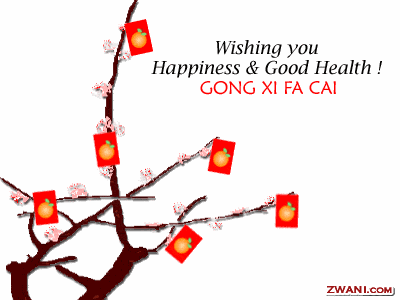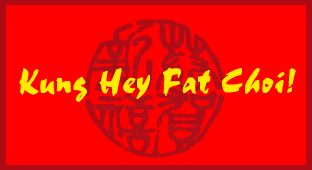
Unlike it's Western counterpart the Chinese New Year (also known as Spring Festival) is steeped in tradition and superstition. It is the most important of all Chinese holidays as it is a time of year to welcome a prosperous year, acknowledge and renew family ties and cleanse and refresh the home.
Chinese New Year is celebrated over a period of time. It is celebrated from the first day of the First Moon of the lunar calender. So this can be anytime between January 21st to February 19th. The festivities and preparations begin in December of the current year, and can extend well into the New Year.
This allows time to create, renovate and celebrate one of the most amazing cultures of our world.
House Cleaning TraditionsSweeping out the old year and welcoming in the new year begins long before New Year's Day. All debts must be cleared and new ones must not be undertaken at this time, lest they block prosperity from entering the household. The entire house must be cleaned from top to bottom. The regrets and bad influences of the previous year must be scrubbed away before the house can accept the good fortune of the upcoming year. Doorframes and insulation are reinforced to keep it in. All cleaning and any cutting and trimming, even of hair or fingernails, must be completed before the special day and the materials stored away, lest the good luck accidentally be swept away also.
After the house is cleaned up and debts cleared, the color red is applied to home and occupations to usher in happiness (gong xi) and prosperity (facai). Red mud is applied to the wooden and mud houses to strengthen the window and door frames and seal in the new luck. Where only the cooking fire lights up the home daily, red lanterns are brought out to light up the doorways and bring cheer to passersby and mark the household for visitors.

There is another reason why red adorns both structure and people. The Chinese believe that in winter, the monster named Nian in Chinese is released to eat up human beings. However, it is afraid of the color red and will shy away from anything dressed in red. Moreover, it is also afraid of loud happy noise, hence the emergence of the fire crackers to scare it away and loud beatings of drums to celebratory lion and dragon dances.
At any point after New Year's Day, the floors are once again swept, but this time in a specific pattern, working from the doors toward the center of the house, to hold in the good fortune of the family. To sweep the dirt out over the threshold during this festival is to sweep one of the family away. The rubbish is then carefully removed to a corner of the room, so that no one accidentally tramples it. It may not be thrown out until the fifth day of the festival, and then it must leave by the back door.
Family TraditionsOn the last day of the old year, families come together over a reunion dinner in the home of the eldest member of the family and reminisce (shou sui) about the year gone by. Fish and chicken are always included, symbolising abundance and prosperity; and sometimes leftovers are left deliberately so that there may be surpluses every year (which sounds almost the same as "may there be fish every year"). Other traditional foods at this time are also homophones for good fortune and other desirable things; while the traditional dumplings of northern parts of China resemble gold nuggets. After dinner, the house is given a quick final cleaning. Then the women of the family lay out food and offerings for the ancestors and gods on the family altar, and as midnight approaches, prayers are offered and every window and door in the house is opened. Traditional observance also calls for all fires to be extinguished as well: there is to be no cooking on New Year's Day. Children are encouraged to actively participate throughout, staying up until midnight to greet their parents in the new year, as this is believed to enhance the longevity of their parents.
Blooming plants are brought into the house to accompany the platters of oranges and candies and the special plum tree, living symbols of rebirth and new growth and success in one's career. Without flowers, there can be no fruits. Fortunate the household whose plant comes into bloom exactly on New Year's Day, for that family will have a year of prosperity. The house is decorated in red and gold, the walls are hung with wishes for good fortune written on red paper, and red lanterns are brought outside to light up the night.

The candy trays have their own special significance. Shaped like a circle or octagon (eight-sided, for good fortune), the Tray of Togetherness contains eight different types of candy:
* candied melon (for growth and good health)
* coconut (for togetherness)
* cumquat (gold, for prosperity)
* longnan (for many sons)
* lotus seeds (for many children)
* lychee nut (for strong family relationships)
* melon seeds (dyed red, for truth, sincerity, and happiness)
* peanuts (for long life)
Adults who take candy from the tray leave red envelopes containing money (hong bao) in the centre compartment of the tray. The amount is always even, but never in fours (4 is the number of death).
At midnight of the New Year, the drums start beating, the firecrackers erupt, and the lion and dragon dances begin, chasing away the ancient man-eating monster called "nian" - which translates to "year". The hungry old year tries forever to devour people, but at the new year it is chased away with red fortune and loud noises.
 Honoring Friends and Neighbors
Honoring Friends and NeighborsAs New Year's Day goes, so follows the rest of the year. The deities of heaven and earth are welcomed into the home. Everyone gets dressed in (often new) red clothing, even the sick, because it is unlucky to greet anyone in their bedroom. It is a visiting day, and some consult an almanac to determine the most auspicious direction to head out of the house in the morning. To see or hear songbirds, swallows, or red-coloured birds (in midwinter!) is very auspicious. It is traditional to bring a gift of oranges or tangerines, especially with the leaves intact, and a hong bao when visiting at any time during the New Year festival. It is also traditional for the host to leave the guest with a gift of oranges or tangerines, the same number as was brought but never the exact same fruit, for this would be to disrespect the well-wishing of the guest.
Especially, everyone refrains from disharmony of any kind during this day. Guests are offered only sweet drinks and foods, never anything sour or spicy, so that they might have a sweet disposition. Negative words such as the number four are carefully avoided. Knives and scissors may not be used, since this may cut off good fortune; nor can hair be washed, lest the luck wash out of the house. Those who extinguished fires at midnight must not now light them: so all food to be consumed today must already have been cooked, probably as part of yesterday's feast. Children are given more freedom to be mischievous on this day than on any other (and are given hong bao even so!): for if they cry this day, they will cry for the rest of the year. Death and dying absolutely must not be mentioned, nor can the old year be referred to in any way. It is a new year, and a new beginning.
Other TraditionsThe second and third days are for prayers and visiting the graves of ancestors. Married daughters visit their birth parents on the second day, whom their husbands will also meet on the third and fourth days. No other relatives should be visited on the third, fourth, or fifth day, lest an unwanted argument erupt. It is also a special day for the pet dog, for this day is held to be the birthday of all dogs.
On the fifth day, Po Woo, people stay home to welcome the god of wealth. Obviously it is a very poor idea to go visiting during this day! Visits do resume immediately afterward, however. In northern China, the future flow of wealth is greeted with a feast of "gold nugget" dumplings.
Most people celebrate birthdays and count themselves one year older on the seventh day of the New Year festival, the common man's birthday (renri), with traditional birthday fare of long sweet noodles, red-dyed eggs, and peach-shaped buns with a sweet paste of red bean or lotus at their hearts (sou tao, literally "longevity peach"). Expatriate Chinese may also include a raw fish salad known as yusheng. Because the very long noodles represent longevity, every effort must be made to eat the noodles without cutting or biting them short.
Starting at midnight on the ninth day, prayers and offerings are made to the Jade Emperor of Heaven, giving thanks for his protection. Some regions of China also hold another family reunion dinner before the prayers. The next few days of the festival continue to be visiting days, but the rate of activity is slowly winding down. Stores have reopened, and business is slowly getting back to normal.
On the fifteenth and last day of the New Year festival, also known as the Lantern Festival, candles and lanterns are again lit outside homes and families also walk the street with lit lanterns, this time to guide lost spirits home.
Gong Xi Fa Cai! (Wishing you prosperity!)











